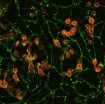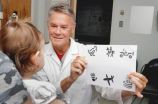(Press-News.org) In close collaboration with Jürg Schönenberger and Yannick Städler from the Department of Botany and Biodiversity Research of the Faculty of Life Sciences, University of Vienna, 14 developmental stages of the flower of Arabidopsis thaliana from very early meristematic floral initiation to fully developed seeds were monitored with micro-computed tomography in 3D. From the same set of developmental stages a full metabolic profile using mass spectrometry was measured covering hundreds of biochemical pathways.
"Smallest changes in floral organ development were thus correlated with distinct metabolic profiles, and remarkable differences in metabolism were detected over the full development", says Wolfram Weckwerth. Based on these data it is possible to define the interaction of developmental processes and metabolism in a hitherto unreached resolution. Thus, the integration of 3D data of developmental processes with metabolic activities opens up a new avenue of research in developmental biology.
Development, Sex and Metabolism
Flower development finds its fulfillment in the fusion of egg cell (ovule) and spermium. The ovule is immovable and safely protected inside the ovary whereas the spermium is mobile and transported via pollen to the female sexual organ. During fertilization the sperm cell makes its way through the elongated pollen tube towards the ovule deep inside the flower. After successful fusion a tiny embryo develops – which can be found in every plant seed.
Whether fertilization is successful relies on the correct timing of the metabolism. It is metabolism that provides all the energy and biomass resources for the developmental processes. Throughout these processes the metabolic activities of the various developmental stages undergo dramatic changes:
In the beginning a high activity of disaccharides and amino acid metabolism can be observed whereas in later stages when the sexual organs become mature monosaccharides, organic acids and different amino acids accumulate. The mature seed, finally, shows a complete different metabolic profile compared to the former ones. "There are specific metabolic signatures which represent the distinct developmental processes of all organs from early flower until fully developed fruit and seed", describes Anke Bellaire, first author of the study.
Future studies will analyze the flower development in other angiosperms lineages to reveal each specific ontogenetic signature / trajectory of the combined metabolic and morphometric profile. Based on these detailed observations generic principles of the interaction of metabolism and development will be identified.
INFORMATION:
Publication in New Phytologist
Anke Bellaire, Till Ischebeck, Yannick Staedler, Isabell Weinhaeuser, Andrea Mair,
Sriram Parameswaran, Toshiro Ito, Jürg Schönenberger and Wolfram Weckwerth:
Metabolism and development – integration of micro computed tomography data and metabolite profiling reveals metabolic reprogramming from floral initiation to silique development.
In: New Phytologist (2014) 202: 322�
DOI: 10.1111/nph.12631
Scientific Contact
Univ.-Prof. Dr. Wolfram Weckwerth
Department of Ecogenomics and Systems Biology
University of Vienna
1090 Vienna, Althanstraße 14 (UZA I)
T +43-1-4277-765 50
M +43-664-60277-765 50
wolfram.weckwerth@univie.ac.at
Press Contact
Mag. Alexandra Frey
Press Office
University of Vienna
1010 Vienna, Universitätsring 1
T +43-1-4277-175 33
M +43-664-602 77-175 33
alexandra.frey@univie.ac.at
The University of Vienna, founded in 1365, is one of the oldest and largest universities in Europe. About 9,500 employees, 6,700 of who are academic employees, work at 15 faculties and four centres. This makes the University of Vienna Austria's largest research and education institution. About 92,000 national and international students are currently enrolled at the University of Vienna. With more than 180 degree programmes, the University offers the most diverse range of studies in Austria. The University of Vienna is also a major provider of continuing education. In 2015, the Alma Mater Rudolphina Vindobonensis celebrates its 650th Anniversary. http://www.univie.ac.at
Flower development in 3D: Timing is the key
2014-07-14
ELSE PRESS RELEASES FROM THIS DATE:
A-maize-ing double life of a genome
2014-07-14
Early maize farmers selected for genes that improved the harvesting of sunlight, a new detailed study of how plants use 'doubles' of their genomes reveals. The findings could help current efforts to improve existing crop varieties.
Oxford University researchers captured a 'genetic snapshot' of maize as it existed 10 million years ago when the plant made a double of its genome – a 'whole genome duplication' event. They then traced how maize evolved to use these 'copied' genes to cope with the pressures of domestication, which began around 12,000 years ago. They discovered ...
Rutgers chemists develop technology to produce clean-burning hydrogen fuel
2014-07-14
Rutgers researchers have developed a technology that could overcome a major cost barrier to make clean-burning hydrogen fuel – a fuel that could replace expensive and environmentally harmful fossil fuels.
The new technology is a novel catalyst that performs almost as well as cost-prohibitive platinum for so-called electrolysis reactions, which use electric currents to split water molecules into hydrogen and oxygen. The Rutgers technology is also far more efficient than less-expensive catalysts investigated to-date.
"Hydrogen has long been expected to play a vital role ...
Wisconsin scientists find genetic recipe to turn stem cells to blood
2014-07-14
MADISON, Wis. — The ability to reliably and safely make in the laboratory all of the different types of cells in human blood is one key step closer to reality.
Writing today in the journal Nature Communications, a group led by University of Wisconsin-Madison stem cell researcher Igor Slukvin reports the discovery of two genetic programs responsible for taking blank-slate stem cells and turning them into both red and the array of white cells that make up human blood.
The research is important because it identifies how nature itself makes blood products at the earliest ...
Testicular cancer rates are on the rise in young Hispanic Americans
2014-07-14
A new analysis has found that rates of testicular cancer have been rising dramatically in recent years among young Hispanic American men, but not among their non-Hispanic counterparts. Published early online in Cancer, a peer-reviewed journal of the American Cancer Society, the findings indicate that greater awareness is needed concerning the increasing risk of testicular cancer in Hispanic adolescents and young adults, and that research efforts are needed to determine the cause of this trend.
Testicular cancer is one of the most common types of cancer among adolescent ...
Potential Alzheimer's disease risk factor and risk reduction strategies become clearer
2014-07-14
COPENHAGEN – Participation in activities that promote mental activity, and moderate physical activity in middle age, may help protect against the development of Alzheimer's disease and dementia in later life, according to new research reported today at the Alzheimer's Association International Conference® 2014 (AAIC® 2014) in Copenhagen.
Research reported at AAIC 2014 also showed that sleep problems – especially when combined with post-traumatic stress disorder (PTSD) – may increase dementia risk in veterans. Additionally, in a population of people age 90 and older, ...
Weighty issue: Stress and high-fat meals combine to slow metabolism in women
2014-07-14
VIDEO:
Researchers at The Ohio State University Wexner Medical Center have found that women who ate a high-fat meal the day after a stressful event metabolized food more slowly, and the...
Click here for more information.
COLUMBUS, Ohio – A new study in women suggests that experiencing one or more stressful events the day before eating a single high-fat meal can slow the body's metabolism, potentially contributing to weight gain.
Researchers questioned study participants about ...
Prehistoric 'bookkeeping' continued long after invention of writing
2014-07-14
An archaeological dig in southeast Turkey has uncovered a large number of clay tokens that were used as records of trade until the advent of writing, or so it had been believed.
But the new find of tokens dates from a time when writing was commonplace – thousands of years after it was previously assumed this technology had become obsolete. Researchers compare it to the continued use of pens in the age of the word processor.
The tokens – small clay pieces in a range of simple shapes – are thought to have been used as a rudimentary bookkeeping system in prehistoric ...
The Lancet Neurology: Post-concussion 'return to play' decision for footballers should be made solely by doctors, says new editorial
2014-07-14
An editorial published today in The Lancet Neurology calls for sports authorities to take into consideration the long term neurological problems that repeated concussions can cause.
Cerebral concussion is the most common form of sports-related traumatic brain injury (TBI), and the long-term effects of repeated concussions may include dementia, amyotrophic lateral sclerosis, and other neurological disorders, say the journal editors.
However, what is perhaps more concerning, is that even when the symptoms of concussion are delayed, or if they come and go quickly, neurological ...
The Lancet Oncology: Differences in treatment likely to be behind differing survival rates for blood cancers between regions within Europe
2014-07-14
Failure to get the best treatment and variations in the quality of care are the most likely reasons why survival for blood cancer patients still varies widely between regions within Europe, according to the largest population-based study of survival in European adults to date, published in The Lancet Oncology.
"The good news is that 5-year survival for most cancers of the blood has increased over the past 11 years, most likely reflecting the approval of new targeted drugs in the early 2000s such as rituximab for non-Hodgkin lymphoma and imatinib for chronic myeloid leukaemia", ...
MUHC researcher unveils novel treatment for a form of childhood blindness
2014-07-14
This news release is available in French.
Montreal, July 13, 2014 — An international research project, led by the Research Institute of the McGill University Health Centre (RI-MUHC) in Montreal, reports that a new oral medication is showing significant progress in restoring vision to patients with Leber congenital amaurosis (LCA). Until now, this inherited retinal disease that causes visual impairment ranging from reduced vision to complete blindness, has remained untreatable. The study is published today in the scientific journal The Lancet.
"This is the first ...






